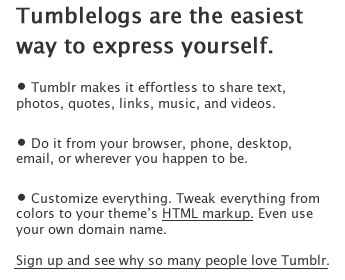The power of bullet points
Bullet points, those little dots placed next to a sentence, are a powerful tool to communicate in digital environments.
Users unconsciously appreciate content organized in small slots of information. Bullet points (when used properly) give readers the joy of reading more efficiently.
From the side of the editor, writing content with bullet points force the writer to reduce the amount of information to be shown, forcing to re-think what is critical and what is less important.
Readers, on the other side, will pay more attention to content organized with this typographical resource. Our eyes are more willing to watch at this little dots than to the rest of the “straight” content. They seem to have the more important information.

FriendFeed bullet points
Bullet points can be an important tool when launching a new product and explaining what is all about. Good examples of a well applied use of bullet points can be seen in FriendFeed´s homepage. Three “thumbnail bullets” explain what the service is about:

Tumblr´s home page
Tumblr is less explicit, and the hole service is explained using a block of text:

Tumblr suggestion
A different approach, using bullet points, could be this one:
No more than seven items:
According to George A. Miller´s “Magic 7” article (1956), number “seven” is almost universally accepted as the human capacity limit for a wide range of issues. This “law” also applies to the use of bullets: more than seven items reduce the power of communication in digital screens.
No less than three:
If you only have two bullets, maybe the right approach would be (again) to reduce those two lines into one single line. While two bullets are meaningful, three bullets are the perfect number.

